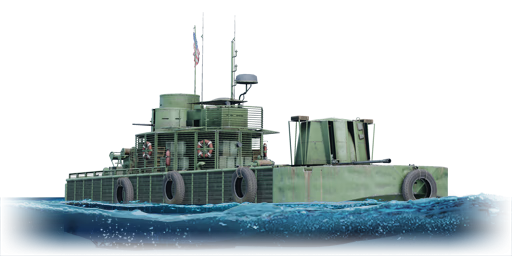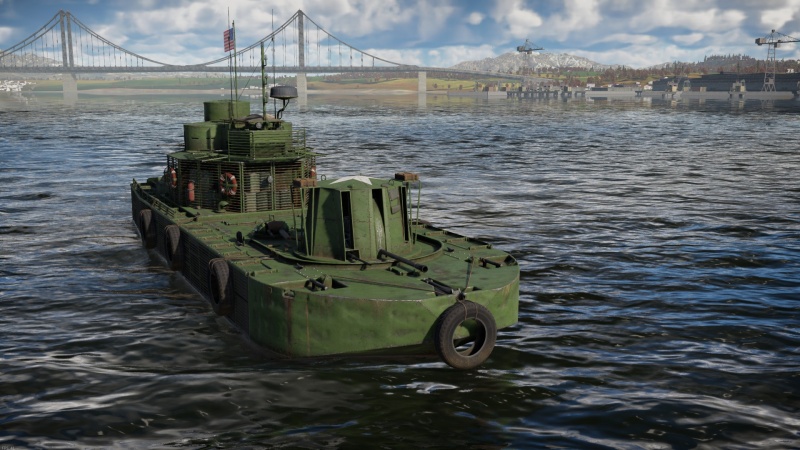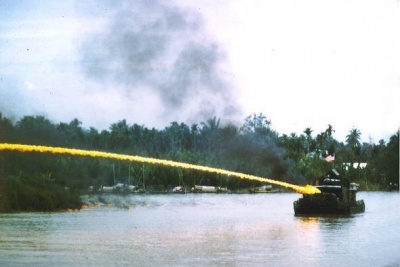Difference between revisions of "LCM(6) Zippo"
(→Ammunition: Converted to transclusion) |
angelomorte (talk | contribs) (Tag: Visual edit) |
||
| Line 1: | Line 1: | ||
| + | [[File:1wqfkg7ey24b1 (1).webp|thumb]] | ||
{{Specs-Card | {{Specs-Card | ||
|code=us_lcm_zippo | |code=us_lcm_zippo | ||
Revision as of 23:22, 4 June 2023
Contents
Description
The Landing Craft Support (Flamethrower) Zippo is a premium gift rank III American armoured gun boat with a battle rating of 2.3 (AB/RB/SB). It was introduced in Update "Fire and Ice" as a reward for Battle Pass: Season IX, "Smell of Victory".
General info
Survivability and armour
Talk about the vehicle's armour. Note the most well-defended and most vulnerable zones, e.g. the ammo magazine. Evaluate the composition of components and assemblies responsible for movement and manoeuvrability. Evaluate the survivability of the primary and secondary armaments separately. Don't forget to mention the size of the crew, which plays an important role in fleet mechanics. Save tips on preserving survivability for the "Usage in battles" section. If necessary, use a graphical template to show the most well-protected or most vulnerable points in the armour.
Mobility
Write about the ship's mobility. Evaluate its power and manoeuvrability, rudder rerouting speed, stopping speed at full tilt, with its maximum forward and reverse speed.
| Mobility Characteristics | |||
|---|---|---|---|
| Game Mode | Upgrade Status | Maximum Speed (km/h) | |
| Forward | Reverse | ||
| AB | |||
| Upgraded | 21 | 16 | |
| RB/SB | |||
| Upgraded | 16 | 12 | |
Modifications and economy
Armament
Primary armament
Provide information about the characteristics of the primary armament. Evaluate their efficacy in battle based on their reload speed, ballistics and the capacity of their shells. Add a link to the main article about the weapon: {{main|Weapon name (calibre)}}. Broadly describe the ammunition available for the primary armament, and provide recommendations on how to use it and which ammunition to choose.
- Universal: AP-T · HEFI-T
- 40 mm AP clips: AP-T · AP-T · AP-T · HEFI-T
- 40 mm HE clips: HEFI-T · HEFI-T · HEFI-T · AP-T
| Penetration statistics | |||||||
|---|---|---|---|---|---|---|---|
| Ammunition | Penetration @ 0° Angle of Attack (mm) | ||||||
| 10 m | 100 m | 500 m | 1,000 m | 1,500 m | 2,000 m | ||
| HEFI-T | 3 | 3 | 3 | 3 | 3 | 3 | |
| AP-T | 81 | 78 | 68 | 58 | 49 | 41 | |
| Shell details | ||||||||||||
|---|---|---|---|---|---|---|---|---|---|---|---|---|
| Ammunition | Velocity (m/s) |
Projectile mass (kg) |
Fuse delay (m) |
Fuse sensitivity (mm) |
Explosive mass (TNT equivalent) (g) |
Ricochet | ||||||
| 0% | 50% | 100% | ||||||||||
| HEFI-T | 874 | 0.9 | 0 | 0.1 | 67.13 | 79° | 80° | 81° | ||||
| AP-T | 874 | 0.89 | - | - | - | 47° | 60° | 65° | ||||
Secondary armament
Some ships are fitted with weapons of various calibres. Secondary armaments are defined as weapons chosen with the control Select secondary weapon. Evaluate the secondary armaments and give advice on how to use them. Describe the ammunition available for the secondary armament. Provide recommendations on how to use them and which ammunition to choose. Remember that any anti-air armament, even heavy calibre weapons, belong in the next section. If there is no secondary armament, remove this section.
- Universal: HEF-T · HEF-I · AP-T
- 20 mm HE: HEF-T · HEF-I · AP-T · HEF-I
- 20 mm AP: AP-T · AP-T · AP-T · HEF-I
| Penetration statistics | |||||||
|---|---|---|---|---|---|---|---|
| Ammunition | Penetration @ 0° Angle of Attack (mm) | ||||||
| 10 m | 100 m | 500 m | 1,000 m | 1,500 m | 2,000 m | ||
| HEF-T | 2 | 2 | 2 | 2 | 2 | 2 | |
| AP-T | 34 | 32 | 24 | 17 | 12 | 8 | |
| HEF-I | 2 | 2 | 2 | 2 | 2 | 2 | |
| Shell details | ||||||||||||
|---|---|---|---|---|---|---|---|---|---|---|---|---|
| Ammunition | Velocity (m/s) |
Projectile mass (kg) |
Fuse delay (m) |
Fuse sensitivity (mm) |
Explosive mass (TNT equivalent) (g) |
Ricochet | ||||||
| 0% | 50% | 100% | ||||||||||
| HEF-T | 830 | 0.12 | 0 | 0.1 | 6.57 | 79° | 80° | 81° | ||||
| AP-T | 830 | 0.12 | - | - | - | 47° | 60° | 65° | ||||
| HEF-I | 830 | 0.12 | 0 | 0.1 | 11.17 | 79° | 80° | 81° | ||||
Anti-aircraft armament
Flamethrowers are a very unique weapon in naval battles and can even burn on the ocean's surface. The system mounted to the LCM(6) Zippo has long range for a flamethrower, but it is very short-ranged in terms of naval weapons.
Like the Churchill Crocodile, one of this weapon system's disadvantages is being mounted to a vehicle that cannot quickly close the gap between it and the enemy to get within range. If they do, however, the flamethrower can make quick work of small vessels with open gun positions. Larger vessels hit by the flamethrowers can be distracted by the fires, as they can be deadly if left uncontrolled.
Though the system is bound to the anti-aircraft suite, the flamethrowers unfortunately do not have the traverse speed or range to effectively combat enemy aircraft. Like other naval weapons, flamethrowers will elevate so that they can reach their effective ranges but with the dual mount, the M73 machine guns will be elevated the same. This means that while the flamethrowers can get on target, the machine guns will be elevated to such a degree that they become virtually unusable since bullet drop differs significantly from the fire arc.
Usage in battles
Describe the technique of using this ship, the characteristics of her use in a team and tips on strategy. Abstain from writing an entire guide – don't try to provide a single point of view, but give the reader food for thought. Talk about the most dangerous opponents for this vehicle and provide recommendations on fighting them. If necessary, note the specifics of playing with this vehicle in various modes (AB, RB, SB).
Pros and cons
Pros:
- 40 mm Bofors and several 20 mm Oerlikon autocannons
- Features two flamethrowers as a deadly close-range weapon
- Napalm fuel can light the water surface on fire for a brief moment, causing any boats that pass on it to catch fire
Cons:
- Abysmal top speed and mobility
- Rather poor survivability due to low crew count
- Shallow draught cause the boat to be constantly rocking around even in calm sea, hampering the accuracy
- The 40 mm Bofors is housed in a turret with poor elevation, leaving the boat vulnerable to aircraft attacks
History
Many WWII-surplus LCMs (Landing Craft, Mechanized) were modified by the Mobile Riverine Force in Vietnam as "monitor" patrol craft.
Flamethrowers were added to the LCM(6) which increased the offensive capabilities of the vessel, giving it the ability to clear vegetation and burn out enemy positions by the riverside. These flamethrowers gave the vessel the "Zippo" nickname, after a popular brand of cigarette lighters.
Media
- Videos
See also
Links to articles on the War Thunder Wiki that you think will be useful for the reader, for example:
- reference to the series of the ship;
- links to approximate analogues of other nations and research trees.
External links
| USA boats | |
|---|---|
| Motor torpedo boats | PT-3 · PT-6 · PT-20 · PT-71 · PT-103 · PT-109 · PT-174 |
| PT-200 · PT-314 · Thunderbolt (PT-556) · PT-565 · PT-658 · PT-810 · PT-811 · PT-812 | |
| Motor gun boats | Kim Qui · LCS(L)(3) · PT-59 · PTF-7 · USS Candid · USS Asheville · USS Douglas · USS Flagstaff · USS Tucumcari · USS Cyclone |
| Armoured gun boats | LCM(6) Zippo |
| USA premium ships | |
|---|---|
| Motor torpedo boats | PT-3 · PT-109 · PT-174 · Thunderbolt (PT-556) · PT-658 · PT-811 |
| Motor gun boats | LCM(6) Zippo · USS Douglas · USS Flagstaff |
| Sub-chasers | Carmi (PC-466) |
| Destroyers | USS Welborn C. Wood · USS Wilkinson · USS Bennion · USS Cowell · USS Davis · USS Moffett · USS Phelps · USS Frank Knox |
| Light cruisers | USS Detroit · USS Helena |
| Heavy cruisers | USS Des Moines |
| Battleships | USS Arkansas |






